Samsung Galaxy Note 3 Review
by Brian Klug on October 1, 2013 9:00 AM EST- Posted in
- Smartphones
- Samsung
- Mobile
- Android 4.3
- galaxy note 3
CPU Performance
The original Note I played with was based on Qualcomm’s APQ8060 platform with MDM9200 baseband (the so-called Fusion 2 platform) and was for its time a pretty awesome piece of kit, combining LTE and a dual core SoC. The Note 2 I played with next was based on Samsung’s own Exynos 4412 SoC with quad core Cortex A9 at 1.6 GHz and Mali–400MP4 GPU. For the Note 3, I’m looking at a T-Mobile variant (SM-N900T if you want to be exact about it) which means it includes a Snapdragon 800 SoC, and Samsung has gone for the 2.3 GHz bin (really 2.265 GHz rounded up). Inside are 4 Krait 400 CPUs running at up to 2.3 GHz, and Adreno 330 graphics at up to 450 MHz, all built on TSMC’s 28nm HPM HK-MG process.
I should note that this is MSM8974 and not MSM8974AB which oddly enough one of Qualcomm’s customers already announced (Xiaomi for the Mi3) which boosts GPU clocks up to 550 MHz and the LPDDR3 memory interface up to 933 MHz, among a few other changes. I’ve confirmed that GPU clocks on the Note 3 are indeed maxing out at 450 MHz, and quite honestly it’s a bit early for 8974AB in the first place, though it wouldn’t surprise me to see Samsung eventually get that faster bin at some point and put it in something.
I should mention that the Note 3 (like many other Android devices - SGS4, HTC One) detects certain benchmarks and ensures CPU frequencies are running at max while running them, rather than relying on the benchmark workload to organically drive DVFS to those frequencies. Max supported CPU frequency is never exceeded in this process, the platform simply primes itself for running those tests as soon as they're detected. The impact is likely small since most of these tests should drive CPU frequencies to their max state regardless (at least on the CPU side), but I'm going to make it a point to call out this behavior whenever I see it from now on. Make no mistake, this is cheating plain and simple. It's a stupid cheat that most Android OEMs seem to be ok with and honestly isn't worth the effort. Update: Of our CPU tests only AndEBench is affected exclusively by Samsung's optimizations, the performance gain appears to be around 4%. Vellamo is gamed by all of the Snapdragon 800 platforms we have here (ASUS, LG and Samsung). None of this is ok and we want it to stop, but I'm assuming it's not going to. In light of that we're working with all of the benchmark vendors we use to detect and disable any cheats as we find them. We have renamed versions of nearly all of our benchmarks and will have uniquely named versions of all future benchmarks we use. We'll be repopulating our Bench data where appropriate.
CPU performance is honestly excellent. The Galaxy Note 3 is more or less the fastest Android smartphone we've tested up to this point. In the situations where we can do cross platform (OS/browser) comparisons, it isn't quite as fast as the iPhone 5s but in some cases it comes close.

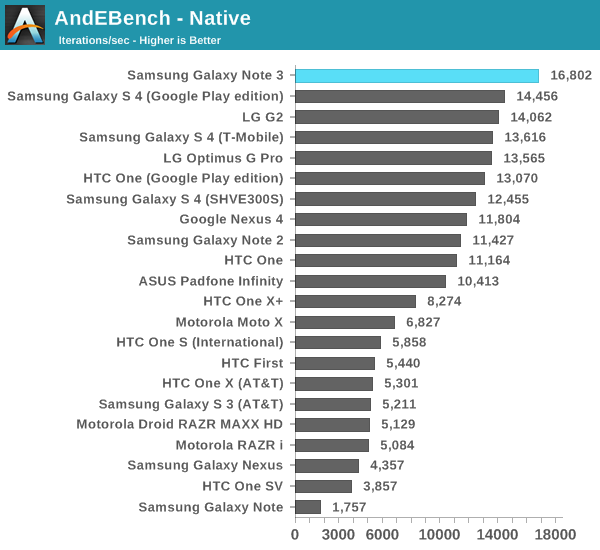
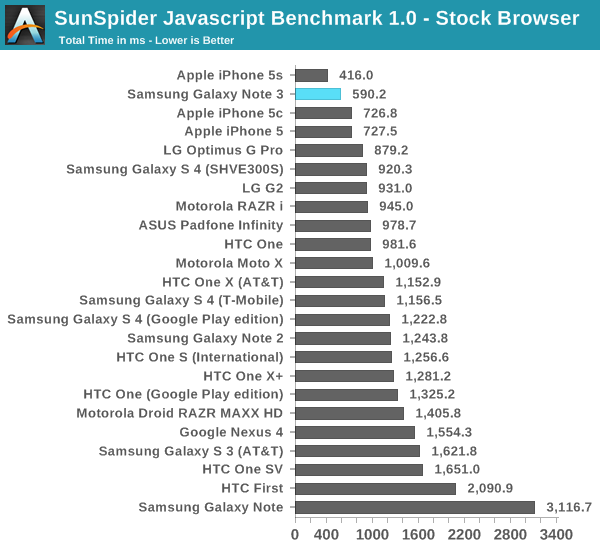

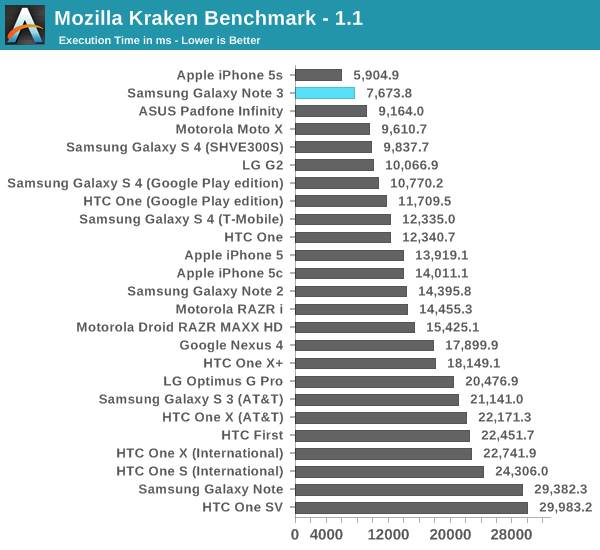
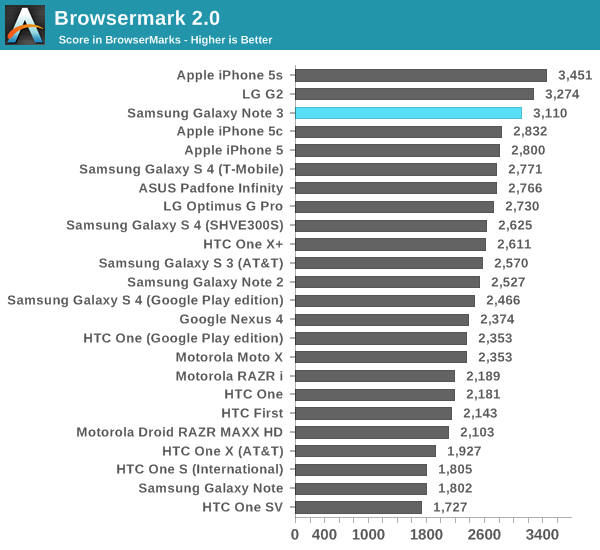
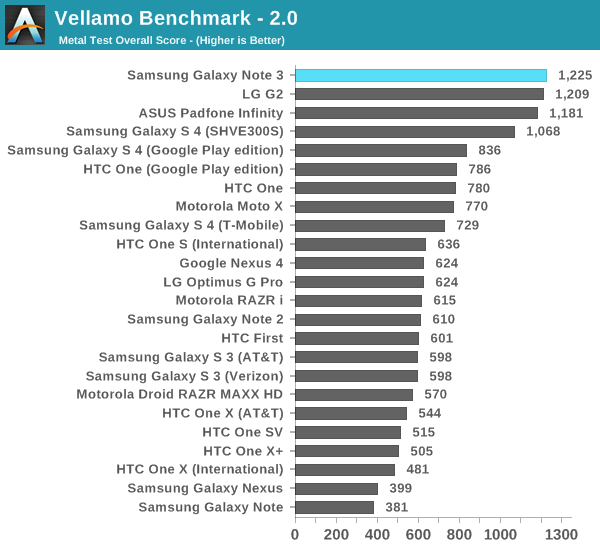

GPU Performance
Samsung definitely likes to win, and the Galaxy Note 3 walks away with the GPU performance crown in literally every single offscreen test we've got here. The onscreen tests are obviously governed by display resolution, but all things being equal the Note 3 manages to get the edge over the PowerVR G6430 in Apple's iPhone 5s. It's also interesting to note that the Galaxy Note 3 appears to outperform all other Snapdragon 800 smartphones we've tested thus far. There's a couple of potential explanations here. First, the Galaxy Note 3 is using newer drivers than any of the other S800 platforms we've tested:
Note 3: 04.03.00.125.077
Padfone: 04.02.02.050.116
G2: 4.02.02.050.141
Secondly, it's unclear how much the manual CPU DVFS setting upon benchmark launch is influencing things - although I suspect it's significant in the case of something like 3DMark.
Finally each manufacturer has the ability to define their own thermal limits/governor behavior, it could simply be that Samsung is a bit more aggressive on this front. We honestly haven't had enough time to dig into finding out exactly what's going on here (Samsung gave us less than a week to review 3 devices), but the end result are some incredibly quick scores for the Note 3. If I had to guess I'd assume it's actually a combination of all three vectors: drivers, high CPU frequencies and being more lenient with thermals.
Update: GFXBench 2.7 isn't affected by any optimizations here, but Basemark X and 3DMark are. We expect the Note 3's performance is inflated by somewhere in the 3 - 10% range. We're working on neutralizing this optimization across our entire suite.

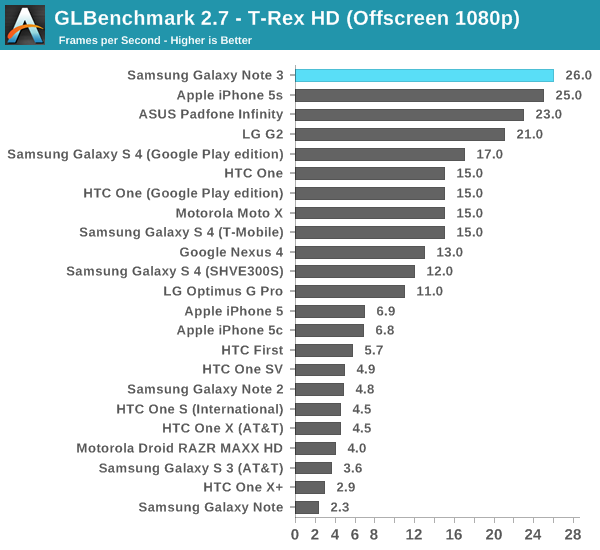
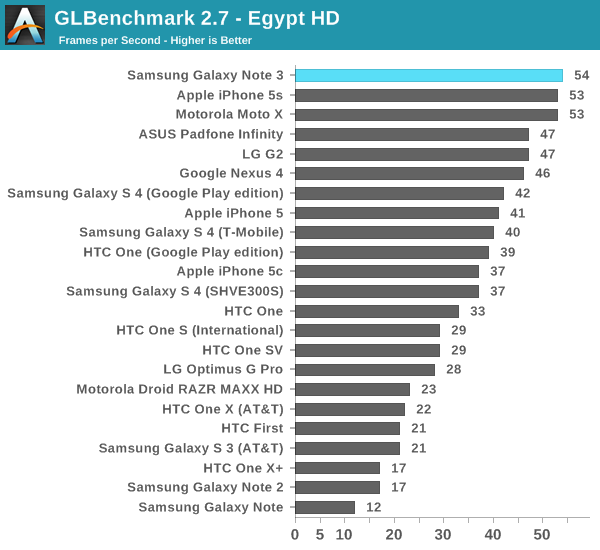
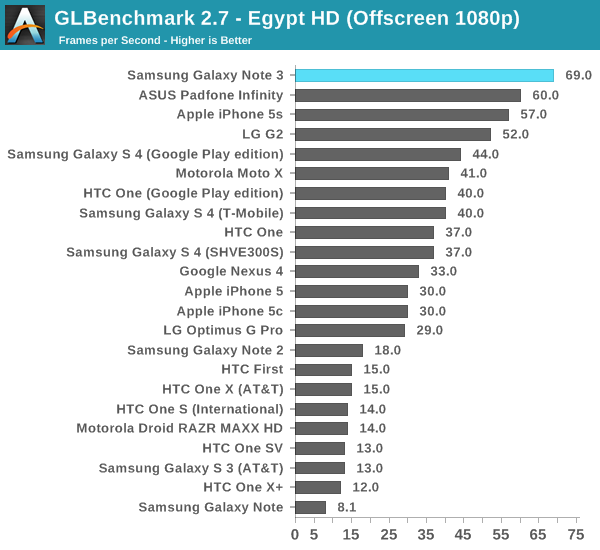
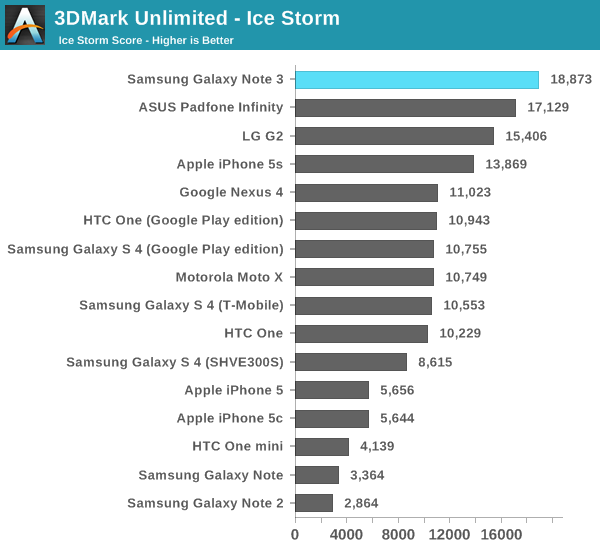
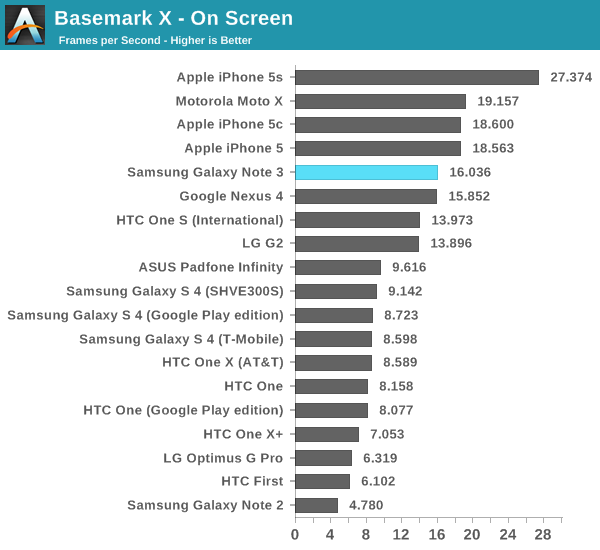
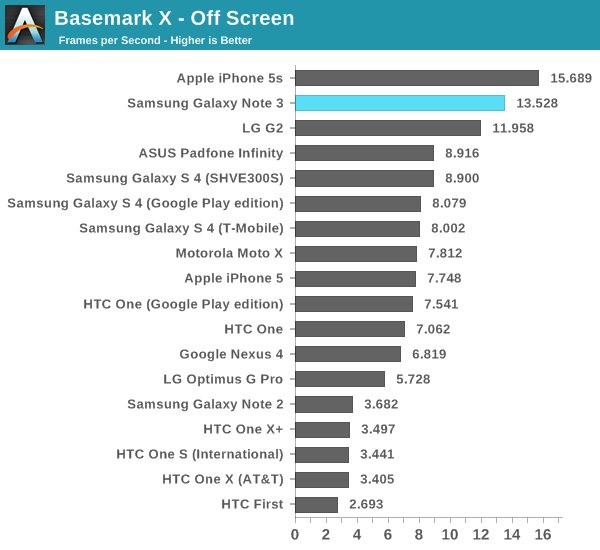

NAND & USB 3.0 Performance
Our Galaxy Note 3 review sample posted some incredible storage performance results, at least compared to all other Android smartphones we've tested. Sequential read and write performance are both class leading - the latter is nearly 2x better than the next fastest phone we've tested. Random read performance is decent, but it's random write performance that's surprising. Unlike the Moto X, the Galaxy Note 3 doesn't rely on a flash-friendly file system to get great random write performance - this is raw eMMC horsepower (if you can call ~600 IOPS that). The result isn't quite as good as what you get out of the Moto X, but it comes very close. Android 4.3 should bring FSTRIM support to the Galaxy Note 3, so as long as you remember to leave around 20% of your storage as free space you should enjoy relatively speedy IO regardless of what you do to the phone.
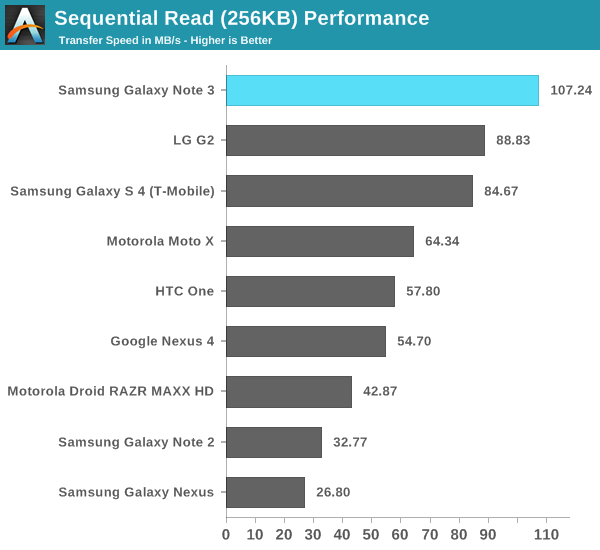
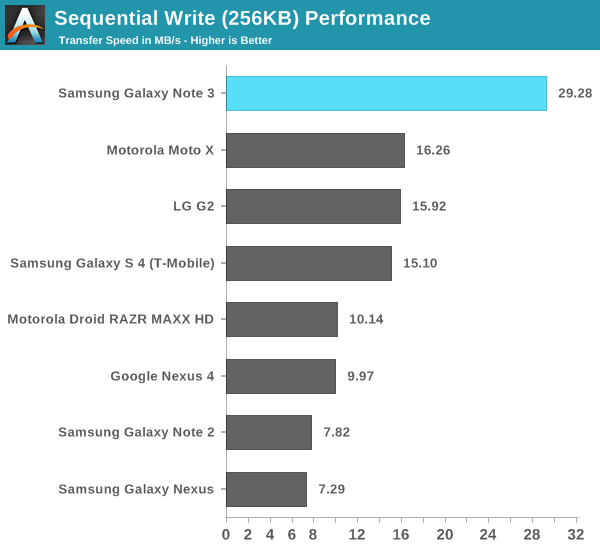
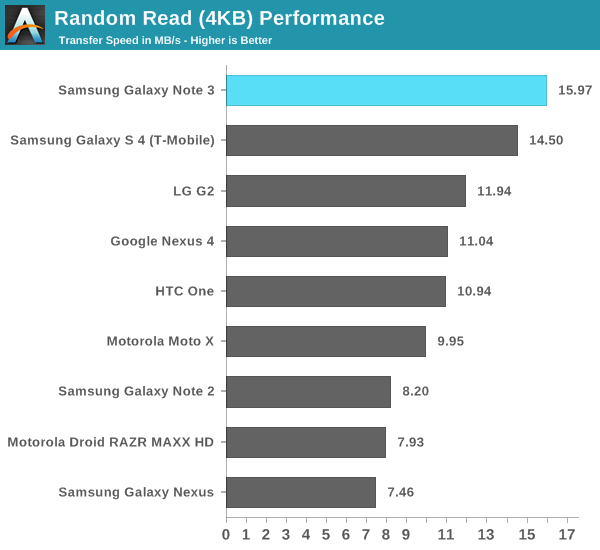

The Galaxy Note 3 ships with USB 3.0, unfortunately at least in its current state it doesn't seem to get any benefit from the interface. Although the internal eMMC is capable of being read from at ~100MB/s, sustained transfers from the device over adb averaged around 30MB/s regardless of whether or not I connected the Note 3 to a USB 2.0 or 3.0 host.
Update: USB 3.0 does work on the Note 3, but only when connected to a Windows PC with USB 3.0. Doing so brings up a new option in the "USB Computer Connection" picker with USB 3.0 as an option. Ticking this alerts you that using USB 3.0 might interfere with calls and data, but then switches over. Connection transfer speed is indeed faster in this mode as well, like you'd expect.
It only appears on Windows as well, my earlier attempts were on OS X where this popup option never appears.



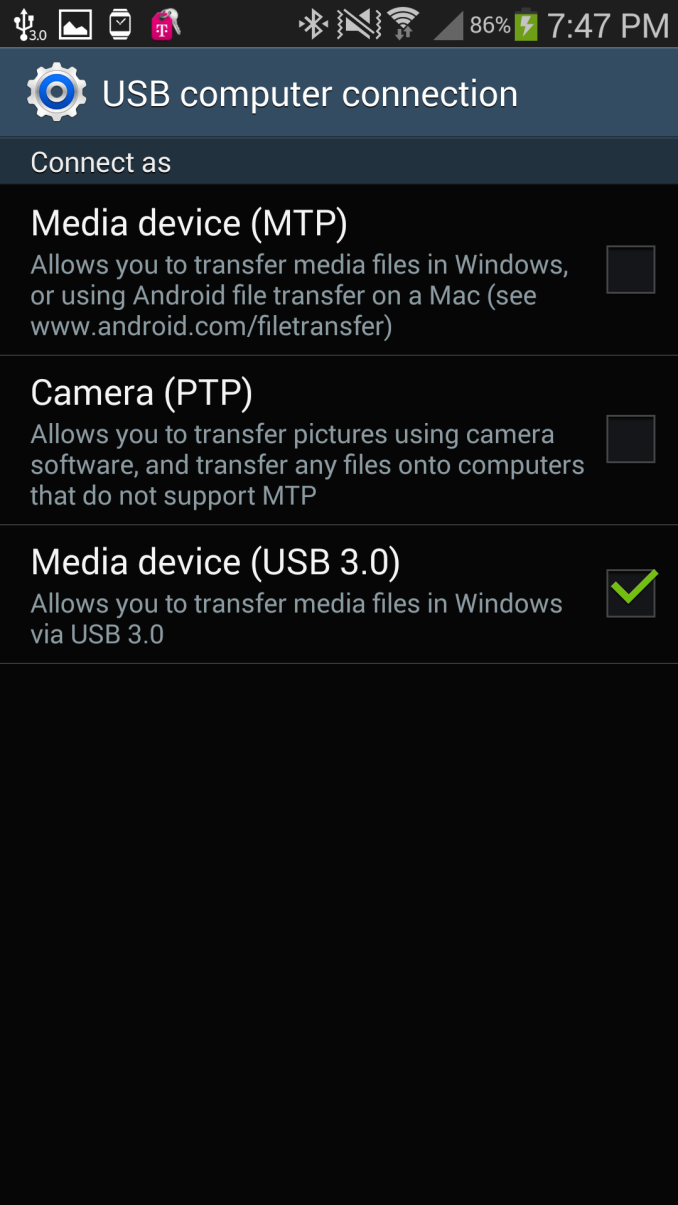
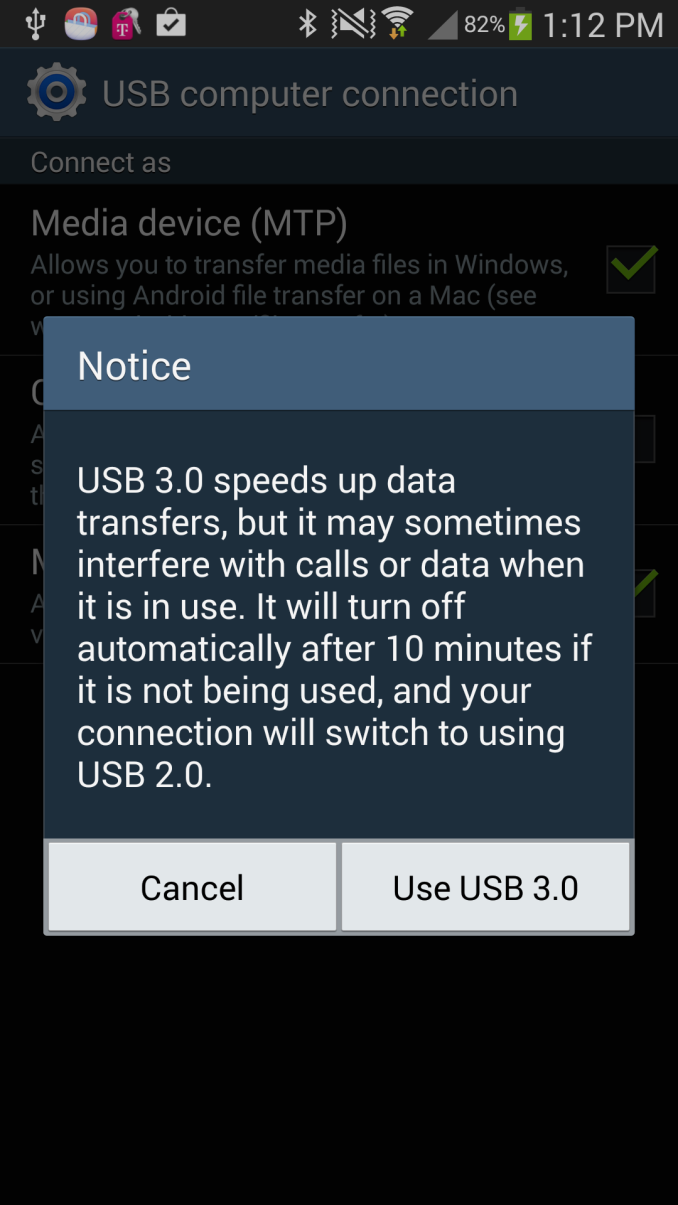








302 Comments
View All Comments
jerry_carter - Wednesday, October 2, 2013 - link
Making a mockery of "The Most Trusted in Tech Since 1997"Anand:
I appreciate your site and reviews and have read religiously for several years now. That stated, the most recent Samsung review [1] falls significantly below your traditional journalistic standards. I use the word 'journalistic' because you've earned it -- working independently when possible and calling out limitations when forced to work within them. You've historically identified significant issues in several products and revised articles or reviewed products when these issues were corrected.
With the Samsung review, you have failed to meet these standards. I accept your comments that benchmarks from several products are suspicious. That is no reason to not take a harder line with each and every case that you encounter. I have no problem with posting the 'manufacture optimized' numbers provided that they are presented in parallel with numbers for with the optimizations are disabled (or believed to be disabled). I do appreciate that this is more work, but your site, Ars Technica, and others can expose corruption (or as least bad behavior) where it occurs and motivate manufactures to 'do the right thing. And really, isn't that what journalism is about?
Thanks for your work over the last several years. I trust that the review will be corrected soon and look forward to that and future work in the months and years ahead.
Best Wishes,
Jerry Carter
[1] http://www.anandtech.com/show/7376/samsung-galaxy-...
ccd2 - Wednesday, October 2, 2013 - link
The popularity of the new iPhone is really amazing. With the maturity of the phone market, the trend seems (to me at least) to be away from a one phone does all to a number of segments. The Note 3 represents one of those segments (I own the Note 2). If I were in the market for a phone, the Note 3 would be my phone. My guess is that, in time, phones like the S4 which I would consider a kitchen sink phone where everything is thrown in, will give way to more phones like the Note 3, which are designed for market segments. My guess is that most people who buy a phone like the Note 3 would not give the iPhone or Galaxy S4 a second look. That is no knock against Apple before the fanboys jump on me. It's just that with a bigger screen, S pen, etc., the Note has a different focus and appeal. You can already see other potential segments like where the phone is more camera than phone. To me, this seems where the phone market is headed as it continues to mature.SeriousTodd - Wednesday, October 2, 2013 - link
Brian, if you could comment on the subject of legitimacy of this website, it would be great.http://www.displaymate.com/OLED_Galaxy_S123_ShootO...
SeriousTodd - Wednesday, October 2, 2013 - link
Brian, it would be great if you could comment on the subject of legitimacy of this website.http://www.displaymate.com/OLED_Galaxy_S123_ShootO...
ChrisMars - Wednesday, October 2, 2013 - link
Great review, thanks!May I propose to adapt the CalMan results graph in a way it's more easy to grasp at a glance?
Just putting the best on top would be a improvement already.
Adding a line at 6505K for white-point deviation would also be good to improve readability,
SpacedCowboy - Wednesday, October 2, 2013 - link
Just one more voice added to the cacophony.I started reading anandtech a long time ago - so long that I don't remember exactly when. The nature of the reviews here caught my eye, and I became a fan. What I liked was how things were made bare, with intelligent guesses (always noted as such) and astute observations leading to conclusions that other sites just didn't provide. Over time, the track record was excellent and trending better.
Now, though, you've just taken a huge step back. Some points:
1) It's not an insignificant difference between the cheating and non-cheating modes as you suggest in the review. Perhaps there's something else going on rather than just locking the clock to fMax - perhaps they're relaxing the thermal envelope as well. Who knows ? It's all very dodgy.
2) It's all very well to say that benchmarks don't mean anything, but a lot of people who don't really know what they want, but just "want the best phone" are going to look up a review on the internet, see which phone is at the top of the graphs, and assume that's the best one, then go out and buy it. Tech-savvy customers are the exception, not the rule, and you've just given Samsung everything they wanted.
3) You say you're struggling with how to react. I'm struggling to see why you're struggling. If someone cheats, you call them on it; simple as that, and you make the cheating the major point of any review. Naming and shaming manufacturers, and the commensurate bad PR is the only way we'll stop them (and by 'we' I mean sites like your good selves).
The only reasons I can see why you wouldn't do this is that you're afraid that you'll lose access to new products in future, or you're being paid to shill their products. If it's the former, well, that's a story in its own right; if the latter (which FYI, I don't believe to be the case), then a sad day has dawned and I'll go somewhere else for my tech reviews.
4) I don't care who does it, be it Apple, Samsung, HTC, whatever - name them and shame them. Cheats should never prosper.
You're in a privileged position. You've gained that position because of your reputation and hard work, by doing the journalistic version of speaking truth to power. It just seems so ... sad ... that you didn't hold yourselves to your previous high standards this time, and I guess we're all just a bit shell-shocked and asking "why ?"
TL;DR: Such a shame.
cozmot - Friday, October 4, 2013 - link
Very good points, and that sums my thoughts up perfectly.Arbie - Wednesday, October 2, 2013 - link
"How is it cheating if everyone does it?" -- First off, it's cheating because it's intentionally misleading; and secondly because not everyone does it. The companies who are not cheating are being shown in a falsely bad light. And I wouldn't have known that from reading this Anandtech article.So Anandtech really needs to highlight the fact in the same chart that presents the results. Or better yet, omit Samsung scores on that parameter and say why.
Samwise - Wednesday, October 2, 2013 - link
Anandtech, please review the Droid MAXX.apljack80 - Wednesday, October 2, 2013 - link
I think I have read enough of these posts to feel like many of your words are an unwarranted attack of the writers of Anandtech. Let me be perfectly clear, Samsung and other OEMs DID NOT CHEAT, and ANANDTECH DID NOT LET THESE COMPANIES OFF THE HOOK. Let me articulate why this is the case.1) First you must look at the device and it’s intended purpose. These are phones not laptops or desktops, that for the most part enjoy an unending stream of power. These phones are designed to sip power with extreme efficiency. As a result, they do this at the cost of unleashing the full potential of the hardware of the phone, in order to optimize the full potential of the battery. Consider all of the effort they have taken to make more powerful CPU’s, GPUs, and bright huge screens use so much less power than their predecessors, think about how much they have accomplished with all this AND make a phone last almost all day.
2) All of these phones are also very efficient crushing the full potential of the hardware, however, a benchmark is testing the efficiency of the hardware not the battery. And this causes benchmarks to become ARTIFICIALLY LOW. So when faced with this issue the OEM’s have made provisions, to allow the device to fully unleash it’s full potential in the code. Try thinking of it like this, Samsung did not improve its scores by adding that code, but let us see what the actual power of the processor is. Other implementations of the same hardware are lower, because the software and power saving devices are forcing it to be slower. That is why you are seeing these ‘special’ cases, because you could not see what the real ability of the phone is without the code.
3) I believe the writers of Anandtech understand this at some level, and lack the ability to truly communicate that message to the masses. If you read their articles, they do feel it is a form of cheating, but have not called it in any way a lie. They walk a fine line between being honest with themselves, and offending a company that sends them devices for review. So they have to be careful in how they word things, and in this case I felt their response was diplomatic to say the least. They did not ignore what is happening like other tech sites, they acknowledged it and reported their raw numbers. The raw numbers that the phone can actually do outside of it’s limitations.
I am embarrassed at what I have seen here today, and I am embarrassed by all of you who have failed to engage you minds on this topic. Think before you speak, you will find more doors will open to you that way. And be grateful they have even replied to any of us during this tirade.